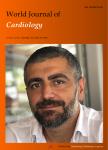Chronic cola drinking induces metabolic and cardiac alterations in rats
Chronic cola drinking induces metabolic and cardiac alterations in rats作者机构:Instituto de Investigaciones Cardiológicas University of Buenos Aires CONICET Division of Cardiology University of Perugia School of Medicine
出 版 物:《World Journal of Cardiology》 (世界心脏病学杂志(英文版)(电子版))
年 卷 期:2011年第3卷第4期
页 面:111-116页
学科分类:1001[医学-基础医学(可授医学、理学学位)] 100104[医学-病理学与病理生理学] 10[医学]
基 金:Supported by Partly Consejo de Investigaciones Científicasy Técnicas (CONICET), and funds from ININCA (UBA) Presented in part at the 20th European Meeting on Hypertension, Oslo,June 17-21, 2010, Norway
主 题:Cola beverages Echocardiography Metabolic syndrome Soft drinks
摘 要:AIM: To investigate the effects of chronic drinking of cola beverages on metabolic and echocardiographic parameters in rats. METHODS: Forty-eight male Wistar rats were divided in 3 groups and allowed to drink regular cola (C), diet cola (L), or tap water (W) ad libitum during 6 mo. After this period, 50% of the animals in each group were euthanized. The remaining rats drank tap water ad libitum for an additional 6 mo and were then sacrificed. Rat weight, food, and beverage consumption were measured regularly. Biochemical, echocardiographic and systolic blood pressure data were obtained at baseline, and at 6 mo (treatment) and 12 mo (washout). A complete histopathology study was performed after sacrifice. RESULTS: After 6 mo, C rats had increased body weight (+7%, P 0.01), increased liquid consumption (+69%, P 0.001), and decreased food intake (-31%, P 0.001). C rats showed mild hyperglycemia and hypertriglyceridemia. Normoglycemia (+69%, P 0.01) and sustained hypertriglyceridemia (+69%, P 0.01) were observed in C after washout. Both cola beverages induced an increase in left ventricular diastolic diameter (C: +9%, L: +7%, P 0.05 vs W) and volumes (diastolic C: +26%, L: +22%, P 0.01 vs W; systolic C: +24%, L: +24%, P 0.05 vs W) and reduction of relative posterior wall thickness (C: -8%, L: -10%, P 0.05 vs W). Cardiac output tended to increase (C: +25%, P 0.05 vs W; L: +17%, not significant vs W). Heart rate was not affected. Pathology findings were scarce, related to aging rather than treatment. CONCLUSION: This experimental model may prove useful to investigate the consequences of high consumption of soft drinks.



